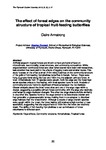The effect of forest edges on the community structure of tropical fruit-feeding butterflies
| dc.contributor.author | Armstrong, C. | |
| dc.date.accessioned | 2019-05-13T15:31:58Z | |
| dc.date.available | 2019-05-13T15:31:58Z | |
| dc.date.issued | 2010 | |
| dc.identifier.citation |
Armstrong, C. (2010) 'The effect of forest edges on the community structure of tropical fruit-feeding butterflies', The Plymouth Student Scientist, p. 3-17. | en_US |
| dc.identifier.issn | 1754-2383 | |
| dc.identifier.uri | http://hdl.handle.net/10026.1/13910 | |
| dc.description.abstract |
Artificial edges in tropical forests are known to have profound effects on microclimate, tree mortality, forest structure, and community composition. While edges between continuous forest and clear felled stands have been well-researched, less attention has been paid to the effects of logging roads and smaller tracks. This study focuses on the effect a small (2-3m wide) road has on the community structure of the guild of fruit-feeding Nymphalidae butterflies in Sabah, Borneo. Traps were hung at ground-level along the road and 100m into the adjacent primary forest. In total, 43 individuals from 17 species were caught. Both the edge and the forest had seven species unique to that habitat, with three species found in both. Analysis of community structure found no significant difference between the two habitats. Cluster analysis placed the three forest sites and one of the edge traps within a cluster, suggesting a possible primary forest community, with the edge site relatively unaffected by edge-mediated changes. The other two edge sites bore little similarity to any other site. Species found at the edge tended to be less shade-tolerant and had generalist or grass-specialist larvae, making them more adapted to disturbed edge habitats than the forest interior. Although a couple of edge-tolerant species were caught within the forest, the forest habitat still retained a high number of tree-specialists, suggesting that any edge effects at 100m into the forest are relatively weak. The ability of fruit-feeding Nymphalidae to act as indicators of forest disturbance is reflected upon. | en_US |
| dc.language.iso | en | en_US |
| dc.publisher | University of Plymouth | |
| dc.rights | Attribution 3.0 United States | * |
| dc.rights.uri | http://creativecommons.org/licenses/by/3.0/us/ | * |
| dc.subject | Edge Effects | en_US |
| dc.subject | Community Structure | en_US |
| dc.subject | Nymphalidae | en_US |
| dc.subject | Tropical Forest | en_US |
| dc.subject | Forest | en_US |
| dc.subject | Butterflies | en_US |
| dc.subject | Fruit-Feeding | en_US |
| dc.title | The effect of forest edges on the community structure of tropical fruit-feeding butterflies | en_US |
| dc.type | Article | |
| plymouth.issue | 2 | |
| plymouth.volume | 3 | |
| plymouth.journal | The Plymouth Student Scientist |



